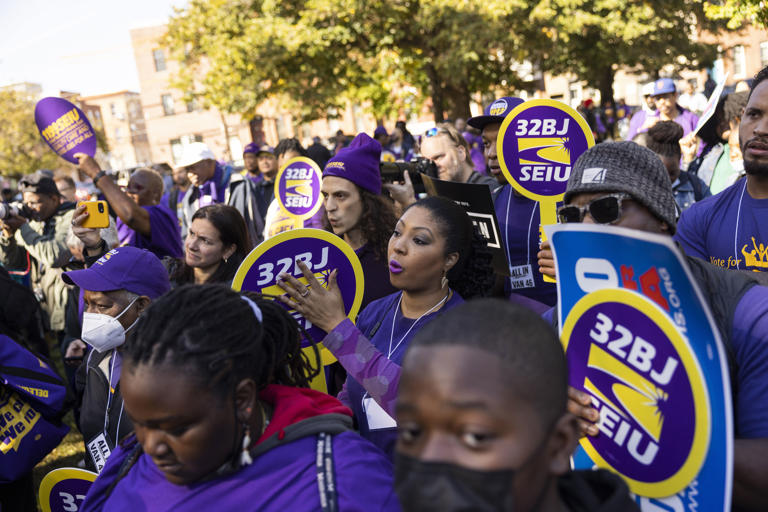The Service Employees International Union (SEIU), representing approximately 2 million healthcare, property service, and government workers, has unveiled ambitious plans to allocate $200 million toward bolstering President Biden and Democratic candidates in crucial electoral battlegrounds across the nation this year, as disclosed by officials familiar with the matter to The Washington Post. This investment marks the union’s largest ever, surpassing the approximately $150 million spent during the 2020 presidential cycle. SEIU aims to engage with 6 million voters of color, with a broader objective of mobilizing working-class voters, many of whom have historically been less likely to vote or have never participated in elections, according to SEIU leaders.
The decision to allocate such a significant sum underscores a mounting concern within Democratic circles regarding President Biden’s capacity to rally support from working-class Black, Latino, and Asian American voters, a demographic that played a pivotal role in his victory in the 2020 presidential election.
While Democrats have traditionally enjoyed strong support from working-class voters of color without college degrees, recent polls have indicated a decline in such backing for President Biden. Notably, the SEIU’s membership comprises a diverse demographic, with 27 percent identifying as Latino, 24 percent as Black, 9 percent as Asian American and Pacific Islander, and 40 percent as White, according to data provided by the union.
SEIU leaders, who endorsed President Biden’s reelection campaign last year, outlined plans to vigorously emphasize to voters the sharp contrast between Biden and former President Donald Trump, both in terms of rhetoric and policy positions.
The stakes for working people are incredibly high, and we are committed to backing our words with action,” stated April Verrett, SEIU’s secretary-treasurer, who is vying for the position of the union’s president upon the retirement of longstanding leader Mary Kay Henry in May.
“When you examine their track records, when you consider their values, the contrast is stark. We are dealing with candidates that are like night and day,” Verrett emphasized. The union has outlined plans to concentrate on mobilizing sporadic voters in pivotal states like Pennsylvania, Michigan, Wisconsin, Nevada, Arizona, and Georgia— all states where President Biden secured victory over Trump in 2020— as well as North Carolina, where Trump emerged victorious in 2020 and where a fiercely contested gubernatorial race is unfolding. Additionally, SEIU intends to allocate resources to California and New York, states where the union boasts a robust membership presence and where several critical U.S. House races will be decided. Investments will also be directed towards Ohio and Montana, where competitive Senate races are underway.
The allocated funds will support an extensive field program, grassroots organizing efforts, advertising initiatives, and collaborations with community organizations in these states. Rocio Sáenz, SEIU’s executive vice president, revealed that the union and its allied groups have already canvassed nearly 900,000 doors as part of the program, which includes outreach in seven languages. Verrett underscored SEIU’s aspiration to build upon the momentum generated by worker strikes and union organizing activities in the past year, viewing it as the union’s responsibility to “connect the dots” and enlighten voters about Biden’s track record on critical issues such as the economy, labor, and healthcare.
Moreover, Verrett emphasized the union’s aim for successes in down-ballot races.
Recent polling data from The New York Times-Siena College indicates a notable shift among non-White voters without bachelor’s degrees— a demographic often categorized as working-class voters of color. While this group favored Biden by 46 percentage points in 2020 exit polls, the recent NYT-Siena poll revealed that Biden’s lead has narrowed to six points, with 47 percent of respondents supporting him and 41 percent backing Trump.
Verrett stressed the significance of engaging people of color in the political process, recognizing their increasing influence. She emphasized the importance of involving them now while there is still a functioning democracy for them to participate in.
However, some working-class voters have voiced frustration with Biden over economic concerns, including rising prices and interest rates. Interviews with voters in battleground states indicate skepticism regarding Biden’s achievements in his first term and a perceived lack of progress on certain promises, such as voting rights and immigration.
The union has conducted roundtable discussions across the nation to gauge voter sentiment. One key takeaway is the widespread unawareness among voters about Biden’s accomplishments during his tenure. As a result, SEIU has prioritized informing voters about Biden’s efforts to lower prescription drug costs, expand access to affordable internet, and his unwavering support for labor unions.
Democratic strategists emphasize the necessity of robust spending and effective messaging to ensure Biden’s success with working-class voters of color in the upcoming elections.
Kristian Ramos, a veteran Democratic strategist and founder of Autonomy Strategies, highlights the Democratic Party’s track record in creating and retaining jobs in industries like manufacturing and construction. He believes that effectively conveying this narrative to working-class Latinos, Black individuals, and AAPI (Asian American and Pacific Islander) communities will drive voter turnout, underscoring the urgency of such efforts in the 2024 political landscape.
Despite these efforts, Biden continues to face challenges with White voters without college degrees, who heavily favored Trump, as indicated by polling data.
